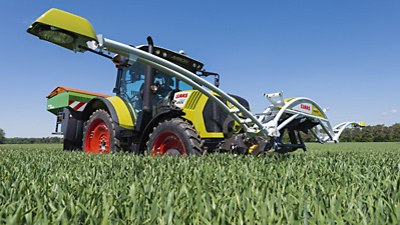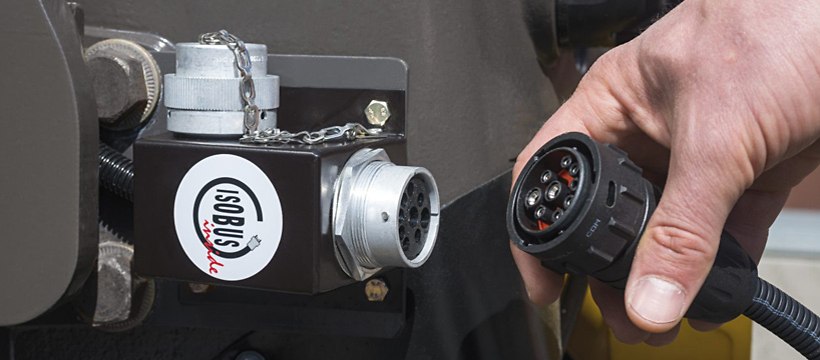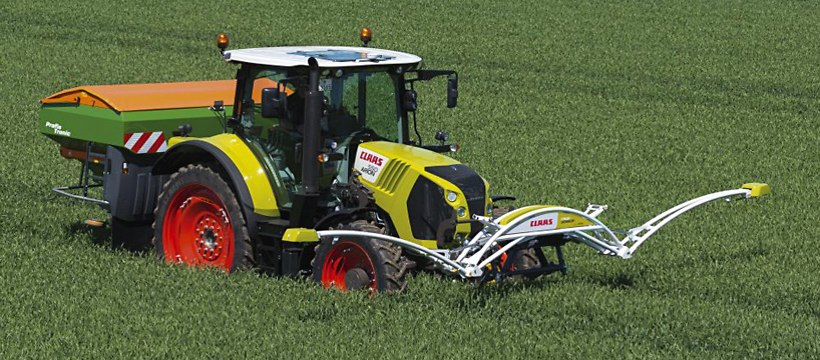Special features of the system include its use of the map-overlay process and single-point calibration, while it is also the only sensor available on the market with an ISOBUS connection. It is being demonstrated in practical operation at the DLG-Fielddays 2014.
The ISARIA CROP SENSOR automatically determines the nitrogen requirement of the plants as the tractor drives along, irrespective of the crop type and variety. Online systems such as the CROP SENSOR measure, calculate and regulate in one operation (in real time). This means that the optimum fertiliser quantity and its application rate are calculated almost simultaneously.
The technology
Use of the ISARIA measurement technology for the CROP SENSOR is based on years of good collaboration between CLAAS and Fritzmeier. The ISARIA CROP SENSOR is an optical sensor with two sensor heads. These are fitted on the right and left of a carrier frame, which is mounted on the tractor's front linkage at a defined distance from the crop. Thanks to active lighting (LED), the crop sensor can be used in the day and at night. The measuring frequency automatically adjusts to the environmental conditions such as the crop density, the intensity of the ambient light and the nutrition level of the plants.
A measurement is taken of the light reflected by the crop under the sensor head. This is used to calculate the IRMI vegetation index, which reflects the current nitrogen supply to the crop. The ISARIA CROP SENSOR measures the quantity of nitrogen which has already been absorbed by the crop up to that point in time, compares this measurement with the target value of the current EC stage and then calculates the missing nutrient difference which needs to be balanced out.
In addition, crop density is measured using the IBI biomass index. If the IBI falls below a particular threshold value, due to drought or frost damage in the field, for example, the spread rate in these subplots reverts to the value defined by the farmer. This combination of the two indices prevents errors.
Usage
The ISARIA CROP SENSOR can be used for any type of crop, at any time and regardless of the application method. If the sensor needs to be calibrated on site, CLAAS now offers a new single-point calibration method alongside the proven two-point calibration method. This operates in a similar way to the existing practice: a representative nutrition level of the crop is determined at specific points of the field. The ISARIA CROP SENSOR responds to variations by regulating the application quantity up and down. There is also the proven ISARIA fertiliser system which, without prior calibration, measures the nutritional status of the crop while driving, thereby enabling optimum nitrogen supply to the crop.
Further developed map-overlay process
As experience shows that the yield over the total area can fluctuate greatly, there is a risk of over- and under-fertilisation. This is where the ISARIA CROP SENSOR utilises the map-overlay process. In addition to the actual and calculated N supply, this process considers the yield potential, to ensure application of the optimum plot-specific spread rate in kg/ha or l/ha. The valuable CLAAS yield mapping data can be used to help determine the yield potential. The ground parameters must also be taken into account, which is also possible through a service of EASY. All of the electronics expertise of CLAAS is combined under the EASY name (Efficient Agriculture Systems).
The ISARIA CROP SENSOR documents all fertilisation measures, which are listed in the field record in the form of an application map and can be used for further processing, such as comparison with the yield map.
The ISARIA CROP SENSOR is currently the only ISOBUS-compatible N sensor on the market. It is operated via the CEBIS MOBILE or other ISOBUS-compatible control terminal. The ISOBUS communication standard permits the use of only one control terminal for the crop sensor and implement. With this, CLAAS has responded to customer demand to reduce the number of control terminals in the cab.












